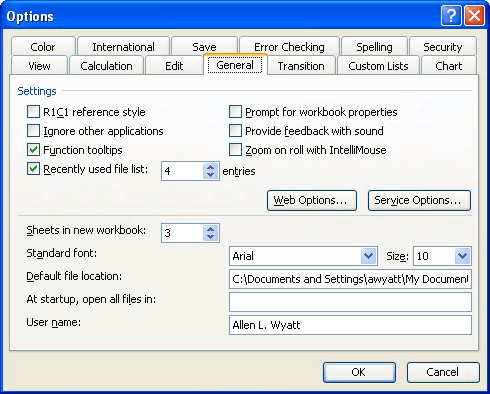Please Note: This article is written for users of the following Microsoft Excel versions: 97, 2000, 2002, and 2003. If you are using a later version (Excel 2007 or later), this tip may not work for you. For a version of this tip written specifically for later versions of Excel, click here: Loading Unwanted Files at Startup.
Written by Allen Wyatt (last updated October 25, 2021)
This tip applies to Excel 97, 2000, 2002, and 2003
Stephen ran into a problem using Excel—every time he starts the program, Excel tries to load all the files in the root directory as spreadsheets. This, of course, messes up his use of Excel.
This problem typically occurs when someone has instructed Excel to load those files. To undo this, follow these steps:

Figure 1. The General tab of the Options dialog box.
The options in steps 3 and 4 represent directories whose files Excel should load whenever you start the program. If you don't want Excel to load any files when it starts, just clear the settings in these options, or make sure they are set to directories that really contain things you want loaded.
It is possible that if one of these options is set to C: (the root directory on a Windows system), and you have a lot of files in the root directory, then Excel will try to load so many files that you won't be able to use it at all in order to perform these steps. If that happens to you, use Windows to move the files from the root directory to a temporary directory, and then start Excel. (You won't have to move any of the folders in the root directory, just files.) Once you change the settings in Excel, as described above, you can use Windows to move the files from the temporary directory back to the root directory.
ExcelTips is your source for cost-effective Microsoft Excel training. This tip (2706) applies to Microsoft Excel 97, 2000, 2002, and 2003. You can find a version of this tip for the ribbon interface of Excel (Excel 2007 and later) here: Loading Unwanted Files at Startup.

Excel Smarts for Beginners! Featuring the friendly and trusted For Dummies style, this popular guide shows beginners how to get up and running with Excel while also helping more experienced users get comfortable with the newest features. Check out Excel 2019 For Dummies today!
When importing information from a CSV file, you may get unintended results from time to time. Here's how to force Excel ...
Discover MoreIf you have a problem that crops up when you first start Excel, it can be a bear to track down the cause of the problem. ...
Discover MoreThe VBA programming language provide with Excel allows you to create and modify text files quite easily. Here's how to ...
Discover MoreFREE SERVICE: Get tips like this every week in ExcelTips, a free productivity newsletter. Enter your address and click "Subscribe."
There are currently no comments for this tip. (Be the first to leave your comment—just use the simple form above!)
Got a version of Excel that uses the menu interface (Excel 97, Excel 2000, Excel 2002, or Excel 2003)? This site is for you! If you use a later version of Excel, visit our ExcelTips site focusing on the ribbon interface.
FREE SERVICE: Get tips like this every week in ExcelTips, a free productivity newsletter. Enter your address and click "Subscribe."
Copyright © 2025 Sharon Parq Associates, Inc.
Comments